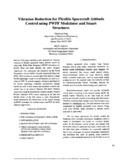Application of piezoceramics to vibration suppression of a spacecraft flexible
| dc.contributor.author | Meyer, John L. | |
| dc.contributor.author | Harrington, William B. | |
| dc.contributor.author | Agrawal, Brij N. | |
| dc.contributor.author | Song, Gangbing | |
| dc.date | July 29-31, 1996 | |
| dc.date.accessioned | 2013-09-30T17:07:52Z | |
| dc.date.available | 2013-09-30T17:07:52Z | |
| dc.date.issued | 1996 | |
| dc.identifier.uri | https://hdl.handle.net/10945/36769 | |
| dc.description | The article of record as published may be located at http://dx.doi.org/10.2514/6.1996-3761 | en_US |
| dc.description.abstract | This paper presents the results of Positive Position Feedback (PPF) control and Linear Quadratic Gaussian (LQG) control for vibration suppression of a flexible structure using piezoceramics. Experiments were conducted on the U.S. Naval Postgraduate Schools Flexible Spacecraft Simulator (FSS), which is comprised of a rigid central body and a flexible appendage. To suppress the vibration of the flexible appendage is the objective of the this research. Experiments show that both control methods have unique advantages for vibration suppression. PPF control is effective in providing high damping for a particular mode and is easy to implement. LQG control provides damping to all modes, however, cannot provide high damping for a specific mode. LQG control is very effective in meeting specific requirements, such as minimization of tip motion of a flexible beam but at a higher implementation cost. | en_US |
| dc.rights | This publication is a work of the U.S. Government as defined in Title 17, United States Code, Section 101. Copyright protection is not available for this work in the United States. | en_US |
| dc.title | Application of piezoceramics to vibration suppression of a spacecraft flexible | en_US |
| dc.type | Article | en_US |
| dc.contributor.department | Department of Mechanical and Aerospace Engineering |





